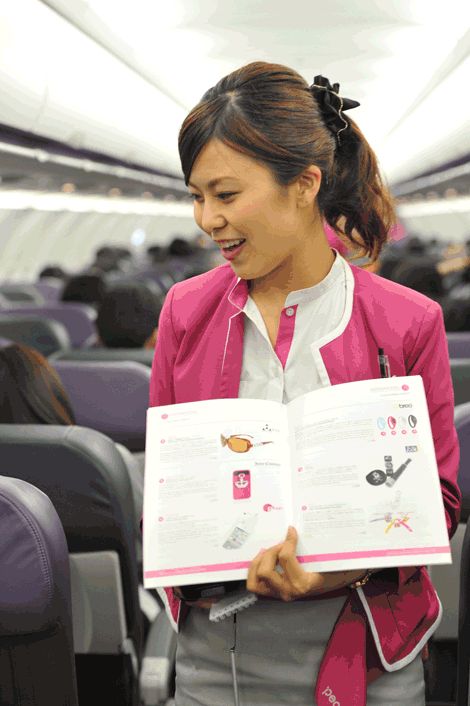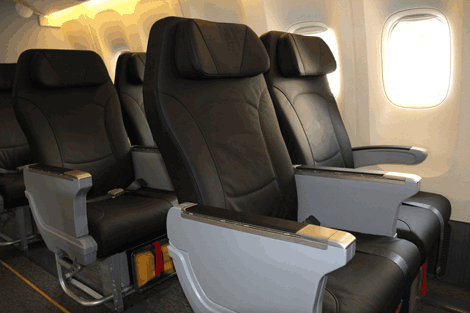When Oasis Hong Kong Airlines went bust in April of 2008 after just 18 months in operation, it became a case study for those who believed that the LCC (low-cost carrier) model would not work on long-haul routes because of high fuel consumption and overhead costs.
The ill-fated airline operated flights from Hong Kong to London and Vancouver, with tickets going as low as £65 (US$98). By the time it went into liquidation, it had reportedly accumulated losses of HK$1 billion (US$128.8 million). High jet fuel costs were indeed blamed for the carrier’s fate, as well as that of three American LCCs – Aloha Airgroup, ATA Airlines and Skybus Airlines – around the same time.
A long shot for low cost?
As Oasis became a memory, Air Asia X, the long-haul sister carrier of Air Asia, marched on, even launching services to London (initially Stansted, then switching to Gatwick in October 2011) and Paris (Orly) in 2009. In the end, though, both routes ceased in March 2012, along with Mumbai and Delhi.
The airline’s chief executive Azran Osman-Rani admitted that high fuel costs were one of the reasons for the cancellations, but added that weakening demand for air travel from Europe and factors such Air Passenger Duty (APD) in the UK were other reasons.
But he dismisses the view that the LCC model cannot work profit-wise on long-haul routes. “It’s a mental block; they assess long-haul LCCs by comparing them to short-haul LCCs, but they don’t realise that I can still get the same utilisation rate,” he says.
He explains that legacy airline aircraft often arrive at an airport and wait for hours before the next departure because they have to make connections with other flights. As their customers pay a premium for their tickets, they also have to opt for convenient time slots. Without that concern, Air Asia X can make quicker turnarounds and save costs. “Conventional airlines fly an aircraft 12 hours a day; I fly it 17 hours a day. In one year, we have 30 to 35 per cent more flights per day,” Osman-Rani says.
Other ways to save costs include having two crew members sharing a hotel room, choosing cheaper hotels, and generally having a lower crew-to-passenger ratio – about 60 to one. That is possible, Osman-Rani continues, because his airline does not have the traditional meal service in-flight. “[Legacy airlines] need 11 crew members for a 290-seater; we can manage with nine in a 377-seater because after the pre-ordered meals and drinks are done, the crew only needs to make one more round to collect the trays.”
Regional opportunities
So why did the Europe-bound services stop? Would the low fares offered by Air Asia X not be exactly what a region bogged down by an economic downturn needs?
Osman-Rani explains: “The problems in Europe are structural – it is going through a depression. We could probably have still continued, but what would be the opportunity cost if you had to go uphill when you could have much better growth in your own back yard?”
Over the past year the airline has rearranged its routes and launched many new services to China and Australia. But although business opportunities abound in this region, the competition is heating up as well.
Jetstar has long dominated the region’s LCC market from its Southeast Asia base in Singapore. It offers flights from Kuala Lumpur to Australia with a stopover in the Lion City. In March last year, it was also announced that Qantas and China Eastern would form a partnership to launch Jetstar Hong Kong, offering low-cost flights to China. Its portfolio also includes Jetstar Japan and Jetstar Pacific (Vietnam).
Scoot, the low-cost offshoot of Singapore Airlines (SIA), began operations in June last year with flights to Sydney, and it also flies to the Gold Coast, various cities in China, Tokyo via Taipei, as well as Bangkok. Last October, it formed a partnership with Tiger Airways – in which SIA has a stake – to allow travellers to book flights by both airlines under one itinerary on a single ticket. That allows the Singapore-based LCC to link Australia with Southeast Asian destinations such as Kuala Lumpur, Hanoi and Colombo, as well as the subcontinent.
Although Scoot’s chief executive Campbell Wilson stresses that his airline is in the game to compete with long-haul operators, the carrier’s network remains regional. “Scoot’s current network is focused on flight durations of four to eight hours from Singapore, which encompasses Australia, China, Japan, India and the Middle East. There are more than enough opportunities to keep us busy for some time to come, before we aggressively pursue longer haul flights,” he says.
The airline currently operates a fleet of long-range, wide-body B777-200s, but it plans to replace them with the 20 B787s it has on order, the first of which is due for delivery next year.

New battlegrounds
An emerging battleground for LCCs is Taiwan. A source from China Airlines (CI) has confirmed that the airline has formed a special team to evaluate the possibility of launching an LCC but, after a year, no conclusion has been reached.
A statement released by the Taiwanese flag carrier says assistance and support from the government are needed for it to build an LCC.
But CI might not have the luxury of time to consider whether or not to enter the low-cost arena. Other than Scoot, Peach Aviation – partially backed by ANA – and Jetstar have also begun flights to Taiwan, and when Jetstar Hong Kong is launched, the Chinese island will also likely be a destination. With CI’s ongoing plan to expand its reach to Japan, the competition brought on by Peach Aviation also cannot be ignored.
After years of stagnation, the Indian aviation industry has begun to show signs of revival after the country’s Cabinet Committee on Economic Affairs approved a new policy last September that would allow up to 49 per cent foreign direct investment in a domestic airline.
In February, Air Asia announced that it had submitted an application to the Indian Foreign Investment Promotion Board (FIPB) for a proposed joint venture with Tata Sons, one of India’s largest conglomerates. At time of press, Air Asia (India) Private Limited has successfully registered its name and has filed an application for incorporation. The airline can begin operations as soon as next month. In an interview with Malaysian newspaper The Star, Air Asia’s group chief executive Tony Fernandes was quoted as saying that pricing will be the determining factor of the airline’s success. He also said that he felt the reason why many Indian carriers had failed was because fare levels were not low enough.
Other than its flagship Air Asia and Air Asia X operations in Kuala Lumpur, and the newly established Air Asia India, Fernandes’ aviation empire also includes Air Asia Japan, Indonesia Air Asia, Thai Air Asia and Air Asia Philippines.
Also in the Philippines, with new capital injected by the San Miguel Corporation, Philippine Airlines (PAL) has embarked on a series of service and product upgrade initiatives, including rebranding its low-cost subsidiary Air Philippines into PAL Express.
Though LCC in management, PAL Express will offer amenities found on full-service airlines such as complimentary snacks, drinks and reading materials on board and allow passengers to earn miles in PAL’s loyalty scheme Mabuhay Miles, with more enhancements to be announced later. Since last year, PAL Express has assumed many routes formerly served by PAL, and it also flies two international routes: Manila-Singapore and Cebu-Hong Kong, using a single-class A320.
Is all competition good?
Not everyone is convinced about the LCC market, though. A spokesperson from Cathay Pacific affirmed to Business Traveller that starting an LCC is not in the airline’s plans, but said the airline does “compete in the low-fare sector by offering extremely attractive fares in our economy class cabins”.
Recently it launched a “fanfares” programme to offer special promotions and has been selling an average of some 2,000 tickets a week through this initiative.
That may be a sign that LCCs are exerting pressure on full-service airlines, especially in regional travel. The upcoming Jetstar Hong Kong, for example, will probably serve a lot of the same Mainland China destinations as Dragonair (KA); while in addition, Mainland LCC Spring Airlines is increasing services to Hong Kong. When asked at a recent press event whether LCCs are cutting into KA’s profit, the airline’s chief executive Patrick Yeung said that his airline would continue to keep its edge through service and product upgrades.
The fact that SIA established Scoot despite also owning regional full-service airline Silk Air means that there is certainly room for the two types of carriers to coexist. “Regional operations can still be full service, just operated with a smaller aircraft and/or lower cost base – such as Silk Air or Dragonair – integrated seamlessly with a long-haul network,” Scoot’s Wilson said.
Last July, Thai Airways launched Thai Smile “light premium” service with an A320 flight to Macau. The network has since expanded to include various domestic routes, three Indian cities, Mandalay in Myanmar and Kuala Lumpur. By year-end, it will be flying under its own code (instead of TG) as a “hybrid LCC“, a TG spokesperson said, but what that really means is an unknown.
Budget business
It is generally believed that LCCs mostly target leisure travellers, especially those travelling with family members. But both Scoot and Air Asia X offer premium products that resemble business class offerings. Lion Air in Indonesia even has a business class.
Scoot features a premium cabin at the front end of its B777s called Scoot Biz, which offers a more bundled fare to include larger seats, preferred seat selection, priority boarding, up to two meals with beverages, 20kg checked baggage allowance, two items of carry-on luggage, a comfort kit, in-seat power and fast-track check-in at a dedicated desk.
Air Asia X offers premium flatbeds that come with perks such as priority seat selection, 25kg baggage allowance, a complimentary meal, and a pillow and blanket.
Lion Air’s business class, on the other hand, has leather seats with legroom of up to 38 inches (96.5 cm), in-flight dining, a dedicated check-in service and even private lounge access – a rarity for LCCs.
But Osman-Rani does not think that his airline is losing out by not having lounges for premium passengers. “Today you can pay US$30 to use a pay-in lounge; credit cards also give you complimentary access to lounges. Why pay US$2,000 for a ticket? People can do the math,” he said. One thing is for sure – LCCs are changing the ecology of the aviation world. Study the history of airlines and you’ll see the rising prominence of LCCs is part of an ongoing evolution. In the 1950s there was only one class on commercial flights (see “Snapshot” on page 15) and only the well-to-do could afford to fly. Different cabins were slowly developed to suit different budgets, and the increasing number of LCCs today simply means more people can travel and there are more options for those who already do – which can only be a good thing for the travel industry.









